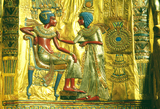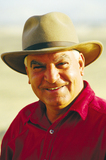|
Face to face with the man who met
Tutankhamun
Archaeologist and Secretary General
of Egypt's Supreme Council of Antiquities Zahi Hawass is credited with
such major discoveries as the tombs of Giza and the Saqqara Pyramids. As a
National Geographic Explorer-in-Residence he recently helped to reopen the
tomb of Tutankhamun so that the mummy could undergo a CT scan to determine
the cause of death for a National Geographic Channel documentary. He
recently talked with 'Taipei Times' staff reporter Gavin Phipps about the
world's fascination with ancient Egypt and the curse of the pharaohs.
Saturday, Jun 11, 2005

|
Archaeologist and
Secretary General of Egypt's Supreme Council of Antiquities Zahi
Hawass peers at Tutankhamun before putting the mummy into a CT scan.
PHOTO COURTESY OF
NATIONAL GEOGRAPHIC CHANNEL
|
Taipei Times: In the seconds before and after you opened the
sarcophagus of Tutankhamun what was going through your mind?
Zahi Hawass: I was so afraid before I saw the mummy. I had had
so many people ask me why I was taking the mummy out of its coffin, that I
was so afraid. When I took the cover off and saw the face I felt magic and
that moment is something I cannot explain to anyone. It was the best
moment in my life.
TT: Do you think that when English archaeologist Howard Carter
opened the virtually intact tomb of Tutankhamun in 1922 that he
unwittingly did more harm than good?
ZH: I think Howard Carter did a good a job in many ways, but
then he did damage it many other ways. If I was him, and had the seen the
gold death mask, I would not have taken it out. I would have left it
there. I see the mask in Cairo Museum all the time and every time I look
at it I think that if it had been left there it would be an incredible
sight today.
TT: Before you resealed the sarcophagus you placed a note inside.
What did it say and why did you do this?

|
PHOTO COURTESY OF NATIONAL
GEOGRAPHIC CHANNEL
|
ZH: The note I wrote said that I, Zahi Hawass, had opened the
sarcophagus in order to perform a CT scan on the mummy of Tutankhamun on
January 5, 2005. I did add something that I didn't tell anyone. I said
that I hope that in the future no one else will take the mummy out of the
coffin and that if they do then the curse of the Pharaohs will be on them.
TT: Do you believe in the curse of the Pharaohs?

|
PHOTO COURTESY OF NATIONAL
GEOGRAPHIC CHANNEL
|
ZH: No, I don't believe in the curse of the Pharaohs, but people
love it.
TT: Why do you think that people of all ages and walks of life,
regardless of religion or nationality, are so fascinated with the history
of ancient Egypt?
ZH: If you look at Egyptian history you see it has the Great
Pyramid and people wonder today how it was built. The Sphinx. People look
at the Sphinx and wonder about its history. Then there are the mummies and
the magic that surrounds them and finally Tutankhamun.
No tomb of any ancient civilization has been found as intact as that of
Tutankhamun and this has enabled us to create an accurate record of his
life and that of the people of the time. These are the reasons I think
Egypt is in the minds of so many people all over the world.
TT: You're a vocal advocate of the need for international museums to
return any and all ancient Egyptian relics to Egypt. Do you think that
such a move is now plausible considering that many of the artifacts have
been housed in museums of international renown for almost a century?
ZH: You have to understand one thing. You have to make a big
difference between a museum showing our artifacts and a museum stealing
our artifacts. I don't mind the showing our artifacts in museums all over
the world, but I do mind if the museum buys stolen artifacts.
To understand my point I'm not after the artifacts in museums to be
brought back to Egypt. I want the big museums to work with us. The British
Museum has the Rosetta Stone and the Berlin Museum has the death mask of
Nefertiti.
I hope that museums such as these can understand and think about
allowing us [the Cairo Museum] to show these artifacts for a few months
for the Egyptian people to see.
TT: Is the illegal trade in stolen Egyptian artifacts still as
rampant today as it was the early part of the 20th Century when Western
explorers first unearthed many of the ancient tombs?
ZH: It's big. I am against people smuggling artifacts and am
against anyone who helps smugglers and who buys stolen artifacts.
We recently caught two thieves who had been smuggling internationally
for the last three years. They had collections in England and North
America. These people are now in jail for 25 years in Egypt.
And we also recently put an American national in jail. He was caught
stealing and selling artifacts from illegal excavations. We need to stop
people from excavating illegally and buying and selling our historical
artifacts all over the world.
My idea is to stop museums from buying stolen artifacts and in doing so
I feel the trade will stop.
TT: Are there still many secrets with regard to the lives and deaths
of Egypt's ancient rulers?
ZH: Thanks to CT scans we now know how Tutankhamun died and have
been able to reconstruct his face. And such technology can help us reveal
other personal secrets of the mummies. But for the most part, we now know
nearly all there is to know about many of the Pharaohs. Very little is not
known about when and how they lived.
There are about 6,000 mummies that are not of Pharaohs in Egypt,
however, and we hope we can learn from more from them.
TT: If you could travel back in time and meet any ancient Egyptian
of your choosing, who would you want to meet and why?
ZH: That would have to be Khufu (2551-2528 BC) because he can
answer so many questions. As the builder of the Great Pyramid of Giza he
built something that is a talking point for people all over the world.
People still wonder about its secrets. He was a great man and I admire
him.
BACK
to The Plateau Homepage |